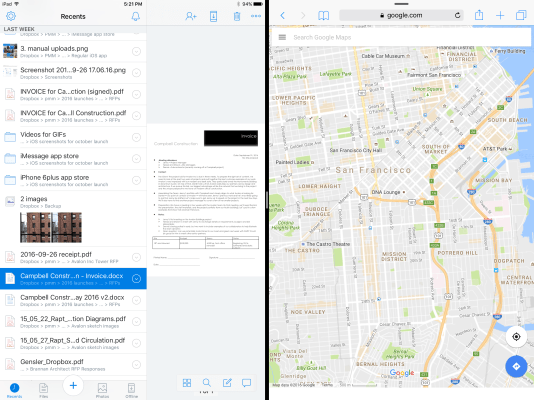Dropbox is still working its way through the enterprise world in order to show the world it isn’t just dumb online storage — which, given as simple as it was to use, was one of the tool’s original top selling points.
So it’s had to shift gears in order to focus on larger companies, and that means consistently rolling out new tools that companies need as they start to expand. And that also means that Dropbox has to keep pace with the rest of the market. So today, to do that, the company is updating its apps with a few new features that should help it continue to have a toehold within larger companies.
“I think overall our approach is, let’s work well extensively across all platforms,” Matt Pan, group product manager for Dropbox’s File Collaboration Product Group said. “We know workplaces increasingly have a set of heterogeneous tools, not just at a platform level like a bunch of people using Mac and Windows. A lot of people have very mixed environments where some people use Office, whether you’re Adobe users or the long tail. Dropbox making all those things tied together in a really simple way has been very much the key to success in the workplace.”
So, here’s a quick rundown of the things that Dropbox is rolling out today:
The first update is PDF signing, which allows users to open PDF files right from their mobile devices and insert signatures and text into them. It seems simple enough, but this is actually a pretty big pain point for a lot of companies that need to get approval for projects and want to keep the ball rolling quickly.
Another update Dropbox is getting today is an integration with iMessage. When Apple opened up iMessage to third-party developers, it became clear to the company that it would have to address the service’s usage within businesses, which was very common, Pan said. So the company is rolling out more rich file-sharing within iMessage that includes previews and the like for its users.
“For workplace communications in a meaningful way we’re seeing [a lot of iMessage use] with small or medium businesses, especially for medium companies — larger companies might be a little stricter with what kind of tools users use,” Pan said. “Within SMBs, we see iMessage used pretty significantly — especially desktop — and for people who have a primarily mobile workforce, like when you have kind of a big real estate team.”
The company is also rolling out a lock-screen widget that will give users the ability to do the most common actions you might find in a Dropbox app from the lock screen. Tapping on one of the functions will go straight to an operation within Dropbox. While this idea might seem useful, Dropbox is still going to have to deal with the constant uphill battle for real estate on that lock screen to ensure that users aren’t getting a cluttered screen and simply ignoring it.
 Later this year, the company is adding split-screen usage on the iPad, so users can have the Dropbox app open while surfing through other services. The strongest use case likely still has to be determined here, but there are some natural ones — like viewing a video while still operating the Dropbox app.
Later this year, the company is adding split-screen usage on the iPad, so users can have the Dropbox app open while surfing through other services. The strongest use case likely still has to be determined here, but there are some natural ones — like viewing a video while still operating the Dropbox app.
The last one is that Dropbox is enabling a picture-in-picture environment on the iPad that allows users to have a video going while they continue to work, similar in the way to YouTube users having a video playing at the bottom-right corner while they are searching for a new video.
All these additions can at times seem incremental (though some, including a literal document scanner through your phone camera, less so), but they’re all an effort to essentially keep pace with the rest of the tools available in the market. Not only does Dropbox have to contend with Box, which started with enterprise customers in the first place, it has to deal with other services like Google Docs, as well. And it seems clear that Salesforce is looking to increasingly get into collaboration services after buying Quip for $750 million.
The company has around 500 million registered users and 200,000 paying customers, it says. While its previous valuation hit as high as $10 billion, there are certainly going to be questions as to whether the traditionally consumer product will be able to pick up steam in the corporate world. Dropbox is banking — including with this update today — that focusing on simplicity and ease of use will give it an edge over those other competitors.
However, there are a couple other uphill battles for Dropbox: Like other services in recent months (some MUCH worse than others), it was revealed that a large chunk of Dropbox’s user base’s credentials were floating around on the dark web. For a company that has to not only have a strong layer of security, but the optics of having a secure infrastructure too, that’s going to be hard to leave behind as it tries to pitch its service to increasingly larger businesses.
